GIZA
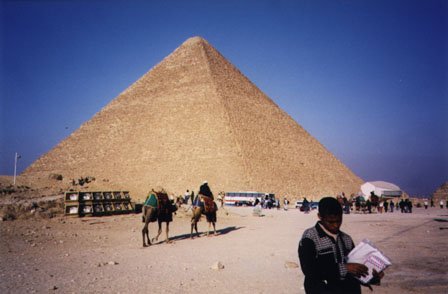
The Great Pyramid at Giza, as seen from the pyramid of Khafre. You can see how the
very top of the pyramid is missing, though the metal tripod that has replaced it does not
show up in the photo. This photo shows the typical crowd scene at Giza, where you see
tourist buses, men selling camel rides, hawkers of postcards and other souvenirs, and of
course the tourists themselves. You can also see a bank of lights that is used in the
nighttime sound and light show. This seems like one of the more crowded and touristy spots
in Egypt, but if you go to the far side of Khafre's pyramid the crowds are gone and you
can get some idea of what the plateau is like in its unspoiled form. There are even tombs
on the Giza Plateau that are open to the public, but they are not advertised, so they see
very little foot traffic.
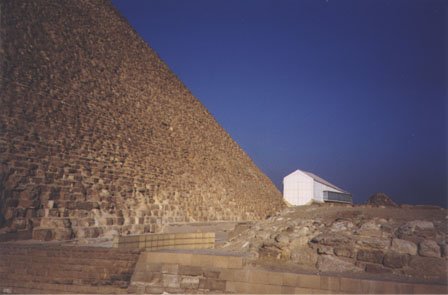
The side of the Great Pyramid with the Solar Boat building along one side. You can
see how craggy the side of the pyramid is without its casing stones. The casing stones
were removed in medieval times to build mosques and a sultan's fortress in Cairo, though
you can still see a portion remaining at the top of the nearby pyramid of Khafre.
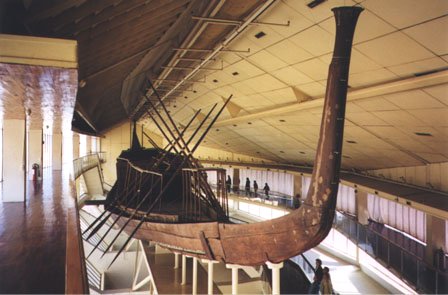
Now inside the Solar Boat Museum, this is a view of the assembled solar boat as
seen from the front, while on the upper walkway of the museum. When found in a pit
alongside the pyramid in modern times, the boat was a jumble of pieces, and was a puzzle
that was painstakingly restored and reassembled by a team of scientists. This boat is
actually capable of floating/sailing, and while it is assumed that its presence at the
site is strictly for religious/symbolic purposes (to carry the pharoah on his symbolic
journey), the boat's hull and gangplank show signs of wear that lead some to believe that
it was actually a working boat at one time. The boat is unique in that all of the hull's
wooden pieces were not held together by nails or pegs, but by rope. When the wood and rope
were put in the water they would swell, and the hull would become watertight. There is a
separate admission fee (and photo/camcorder fees) to see the solar boat, and you have to
put provided cloth covers on your shoes to avoid tracking sand into the building.
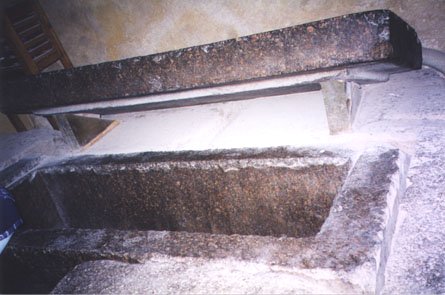
Here's something you don't see in most photo guides.... this is the king's
sarcophagus in the pyramid of Khafre. Unlike the sarcophagus in the Great Pyramid, it is
not a separate piece above floor level, but is instead inset into the floor. In the
background is the lid, which has been propped up at an angle so that you can see its upper
and lower surfaces. See Chris Dunn's
book "The Giza Power Plant" for a fascinating discussion of how the
interior sides of this box are perfectly flat (so flat that if you place an engineer's
steel ruler flat against its sides, and shine a flashlight under it, no light will come
from under the ruler). Using the hammer and chisel method that archeologists claim was
used to create the sarcophagus, it would be impossible to make a surface that perfectly
flat. So how did they do it?
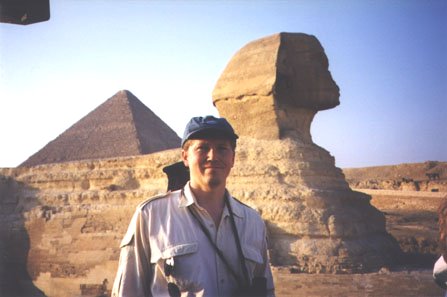
At this time of day (4pm) the face of the Sphinx is in shadow, which doesn't make
for good photos. The Great Pyramid is in the background, and the black hat of a security
officer can be seen directly behind me.
While near the Great Pyramid we saw two men at a nearby tomb.
Striking up a conversation with them, it turns out that one of them was an American
archeologist (the other was an Egyptian antiquities guard). The American was doing field
work on the tomb at that location, and he let us inside to see this tomb, which was not
open to the public. He then advised us to go to the other side of the Great Pyramid, where
there was the tomb of Qar, an ancient high official whose tomb is rarely visited by
tourists. We hiked over to the tomb of Qar, and there were four Arab men there, hanging
around the entrance. They became very friendly when we approached, and invited us to go
down and see the tomb. They made it seem like it was a special event to go inside, and
made a big deal of unlocking the gate and going down the stairway, etc. The main guy
showed us around the inside of the tomb, explaining different features and pointing things
out that he thought we should film. At the end of the tour, it became clear that he
expected a tip ("baksheesh") for being our guide. There was no official entrance
fee for the tomb, and we didn't ask him to show us around, but it was just the way things
are done in Egypt. Prior to leaving the United States we had heard that pens made good
items for tips, so I had bought a box of a dozen pens for a dollar, and I always kept a
few in my backpack. So when it came time to tip this guy, I pulled a couple of small
bills from my pocket and gave it to him. Even before I saw his disappointed face, I
realized I had given him the equivalent of about 15 cents. So I reached into my backpack,
and pulled out a pen, which I gave to him. His face lit up, and he seemed very pleased as
he led us out of the tomb. (I wish I could get that excited over a ten cent item, but then
I guess pens are appreciated in Egypt because they can't get them that cheaply.)
Anyway, by the time we got back outside his buddies were well aware of the
"gift" of a pen, so the tomb guard held out his hand so that he could get one
too. I supposed I could part with another pen, since he did open the locked gate
for us. I pretended to rumage around in my backpack for awhile (even though I knew right
where the batch of pens were), then I gave him the pen. He was also very pleased, but
immediately the other two men wanted pens too. I told them that that was my last pen, but
the truth was I was not going to give out any more pens to this group (especially since
the others did nothing for us, and I didn't want to use up my supply of pens too early in
the trip). The memories of the tomb have faded with time, but the interaction with the
guards (and the pens) will always stick with me.
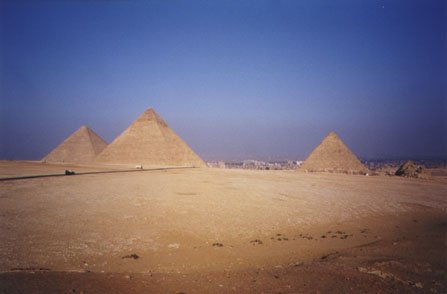
The view from the rise on the far side of the Giza Plateau, where tourists are
frequently driven to get a good photo of the three pyramids from a distance. Left to right
are the pyramids of Khufu (the Great Pyramid), Khafre, and Menkaure. You can see Cairo in
the distance. Cairo actually comes right up to one side of where the pyramids and the
Sphinx are located, surprising some tourists who have only seen photos that show the
pyramids with a desert background, which gives the illusion that the pyramids are out in
the desert somewhere. (There is actually a Pizza Hut a stone's throw from the Sphinx.) The
Giza Plateau seen in the foreground is relatively empty of people, and is the place to go
when you want to see the pyramids in peace and quiet. (Even then you'll have to refuse the
offers of the occasional horse or camel jockeys.)
That was actually the end of our day at Giza, though we did
return for another day on the Giza Plateau after the Nile cruise was over. It was nice to
have an entire day there at the end of the trip, as opposed to the rushed late afternoon
we spent there the first time around.
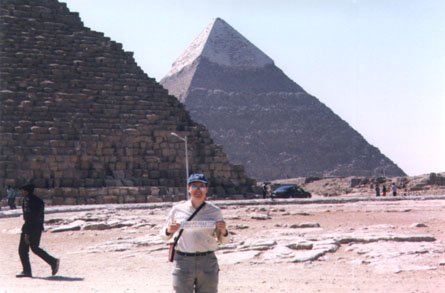
This is on the second day at Giza (our next-to-the-last day in Egypt). I am
standing by Menkaure's pyramid (the smallest of the three at Giza). In the background is
Kaphre's pyramid, which is almost as large as the Great Pyramid. You can see how Kaphre's
pyramid still retains some of its polished outer casing stones near the top (this is
because the casing stones were stripped off of the pyramids to provide building stones for
Cairo, but it's obviously more difficult to do that the higher you go, and that is where
they stopped). I am holding a bumper sticker for the Surfrider Foundation, which is an environmental group that I volunteer
time for. It had become a tradition to have my picture taken with this sticker at remote
places around the world, and this seemed like as good a place as any.
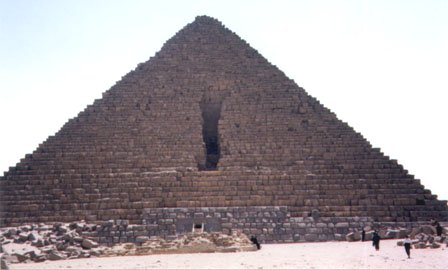
This is the front of Menkaure's pyramid, easily distinguished by the huge
slot-shaped hole in its face (a result of attempts to blast a way into the pyramid during
the Islamic period), and by the fact that it is so much smaller than the other two at
Giza. What I found interesting about this pyramid, though, is that originally the lower
third of it was covered by granite casing stones, which is much more harder to cut and
work with than the standard limestone. You can still see some of the remaining courses of
granite near the base of the pyramid (look for the difference between the grey granite and
the brown limestone). This was the last pyramid that I explored the interior of, which was
interesting and pleasantly free of tourists (due to being farther away from the Great
Pyramid).
Speaking of pyramid interiors, I almost succeeded in a grand
adventure that was planned before even leaving the U.S. I had arranged with a
contact in Egypt to get access to the Great Pyramid after hours, so that I could explore
it without tourists being around. The plan was to dress me up as an Arab, sneak me across
the plateau after midnight, go past the multiple sets of guards (who were to have been
bribed to let me pass), and get into the Great Pyramid, where I would have had the
interior rooms and passages to myself. I would have had about 4 or 5 hours to explore the
pyramid, and could even have gone to those passages and areas that are off-limits to the
public. I have read a lot about the Great Pyramid, and so knew exactly what I wanted to
see and where it was located. Also, the idea of being able to lie down in the granite box
(commonly referred to as the sarcophagus) in the King's Chamber and meditate (or soak in
the energy, or whatever) was very appealing. Unfortunately, I was not able to get back in
touch with my Egyptian contact after the Nile cruise (though I had spoken with him over
the phone when we first arrived in Egypt), and so the adventure ended before it began.
Luckily no money was lost when the deal fell through, though I was very disappointed at
not being able to see those places that I had wanted to see. Sue was relieved, though, as
she was afraid that I would be discovered and arrested, and she would have to fly back to
the States while I rotted in some Middle Eastern prison. The Egyptians don't take kindly
to outsiders taking liberties with their ancient monuments, so admittedly it was a risky
thing to do. (Of course I would never do anything to harm the pyramid, but they
wouldn't know that....) Anyway, it all became a moot point. However, if I get
a chance to attempt it again some day, I'd definitely try again.